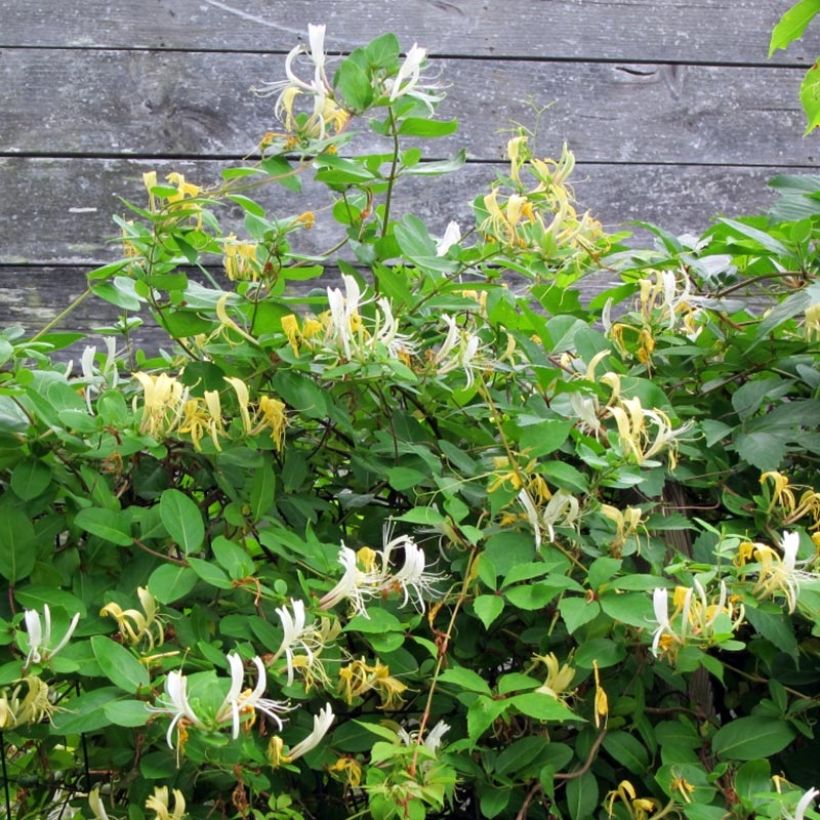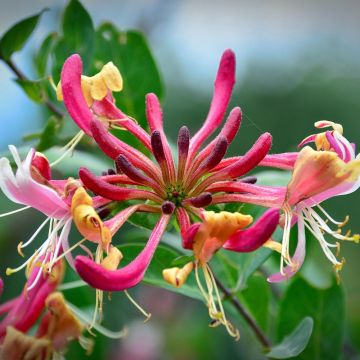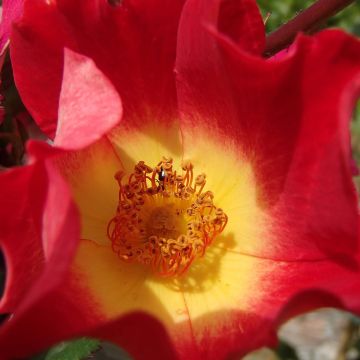

Lonicera japonica Sweet Isabel


Lonicera japonica Sweet Isabel
Lonicera japonica Sweet Isabel
Lonicera japonica Sweet Isabel
Japanese Honeysuckle, Chinese Honeysuckle
Planted in spring 2021 on a trellis. It reaches nearly 3 meters. Well-covered at the top, however, the lower part is sparse despite new shoots every year.
LB, 12/02/2025
Special offer!
Receive a €20 voucher for any order over €90 (excluding delivery costs, credit notes, and plastic-free options)!
1- Add your favorite plants to your cart.
2- Once you have reached €90, confirm your order (you can even choose the delivery date!).
3- As soon as your order is shipped, you will receive an email containing your voucher code, valid for 3 months (90 days).
Your voucher is unique and can only be used once, for any order with a minimum value of €20, excluding delivery costs.
Can be combined with other current offers, non-divisible and non-refundable.
Why not try an alternative variety in stock?
View all →This plant carries a 6 months recovery warranty
More information
We guarantee the quality of our plants for a full growing cycle, and will replace at our expense any plant that fails to recover under normal climatic and planting conditions.

Would this plant suit my garden?
Set up your Plantfit profile →
Description
The Lonicera japonica 'Sweet Isabel' is a variety of Japanese honeysuckle that stands out for its compact habit and its highly fragrant flowering, abundant from summer to autumn! It is a small climbing plant whose twining stems reach 3m (10ft) in all directions very quickly, making it suitable for small spaces and container gardening. Its small, evergreen foliage allows it to provide coverage on structures and trellises throughout the year. Its flowering begins in June with a profusion of tubular flowers in white, then cream and yellow, with long protruding stamens, filling the garden with its powerful fruity fragrance until September. Clusters of small blue-black berries follow, adding a lovely touch to its vegetation. This undemanding climbing bush requires some light for flowering and a location with moist and well-drained soil.
The Japanese honeysuckle, Lonicera japonica in Latin, is a climbing and woody plant, more or less evergreen, belonging to the caprifoliaceae family. This species, which is very easy to grow in all regions, is native to East Asia. In nature, this plant shows vigorous growth, making it suitable for larger, somewhat wild spaces.
The 'Sweet Isabel' variety stands out for its compact habit, evergreen foliage, and generous flowering of yellow-white flowers with a fruity fragrance. With its rapid growth, this honeysuckle will reach approximately 3m (10ft) in all directions. Its long stems twine around any supports they encounter, but they can also crawl and create ground cover. The leaves are simple, ovate, and pointed, thick, heavily veined, arranged in opposite pairs. They are a fairly dark green color, slightly glossy. From June to September, a multitude of 4cm (2in) tubular flowers appear, grouped in clusters at the axils of the leaves. Divided into two lips, they display prominent stamens and change colour from white to cream and yellow as they fade. This flowering, with its sweet and penetrating fragrance, attracts numerous pollinating insects, especially bees and bumblebees, followed in the evening by moths such as Sphinx moths. After pollination, the flowers produce small fleshy berries with a shiny dark purple-black color, which are not edible but highly sought after by birds.
This generous 'Sweet Isabel' honeysuckle can be planted in the ground, away from direct sunlight, with the base shaded; it will be very comfortable, for example, near the trunk of an old tree, between its large roots, as long as it has a good pocket of compost at planting time. Otherwise, consider planting ground cover plants such as geraniums or hypericums in front of it, protecting it from overheating and drying out. It is naturally perfect for covering anything that needs to be hidden: fences, trellises, or sheds, as long as it has a support structure. It is less known for its ability to twine around very narrow supports, transforming even the smallest pole into a vegetated column. It can also be allowed to spread on the ground, in a slightly wild area of the garden. It forms a beautiful combination with clematis, Virginia creeper, ivy, or golden hops. It also fits well into a hedge, alongside flowering shrubs such as lilacs, mock orange, deutzias, or shrubby ceanothus. If you enjoy its fragrance, plant it near the terrace or a window. Its evergreen foliage allows you to camouflage a wall or fence even in winter.
Lonicera japonica Sweet Isabel in pictures




Plant habit
Flowering
Foliage
Botanical data
Lonicera
japonica
Sweet Isabel
Caprifoliaceae
Japanese Honeysuckle, Chinese Honeysuckle
Cultivar or hybrid
Other Honeysuckle
View all →Planting and care
The 'Sweet Isabel' honeysuckle thrives in any good deep garden soil, preferably rich and moist. If the substrate tends to dry out, consider watering during the first summers or placing the base in the shade. Mulch if necessary.
Prefer a sunny exposure to promote flowering, but not scorching. A semi-shaded position (sun in the morning, or under the cover of a tree with light foliage) will also suit it, especially if the sun is intense in your region.
Prune lightly every year if you wish to maintain an orderly shape. Carry out this pruning in early winter to avoid compromising flowering, which occurs on the current year's wood. However, it is possible to severely cut back an older subject to completely renew its structure when it forms a thick mound consisting partly of dead wood. This restoration can be done over one or two years.
Honeysuckles are hardy climbing plants ideal for quickly dressing a wall or pergola. Provide them with support, they will attach themselves. We love them for their long flowering period and wonderful fragrance. Our advice: Plant them near your terrace to fully enjoy their intoxicating scent, which is most pronounced in the morning and evening.
Planting period
Intended location
Care
Planting & care advice
-
, onOrder confirmed
Reply from on Promesse de fleurs
Similar products
Haven't found what you were looking for?
Hardiness is the lowest winter temperature a plant can endure without suffering serious damage or even dying. However, hardiness is affected by location (a sheltered area, such as a patio), protection (winter cover) and soil type (hardiness is improved by well-drained soil).

Photo Sharing Terms & Conditions
In order to encourage gardeners to interact and share their experiences, Promesse de fleurs offers various media enabling content to be uploaded onto its Site - in particular via the ‘Photo sharing’ module.
The User agrees to refrain from:
- Posting any content that is illegal, prejudicial, insulting, racist, inciteful to hatred, revisionist, contrary to public decency, that infringes on privacy or on the privacy rights of third parties, in particular the publicity rights of persons and goods, intellectual property rights, or the right to privacy.
- Submitting content on behalf of a third party;
- Impersonate the identity of a third party and/or publish any personal information about a third party;
In general, the User undertakes to refrain from any unethical behaviour.
All Content (in particular text, comments, files, images, photos, videos, creative works, etc.), which may be subject to property or intellectual property rights, image or other private rights, shall remain the property of the User, subject to the limited rights granted by the terms of the licence granted by Promesse de fleurs as stated below. Users are at liberty to publish or not to publish such Content on the Site, notably via the ‘Photo Sharing’ facility, and accept that this Content shall be made public and freely accessible, notably on the Internet.
Users further acknowledge, undertake to have ,and guarantee that they hold all necessary rights and permissions to publish such material on the Site, in particular with regard to the legislation in force pertaining to any privacy, property, intellectual property, image, or contractual rights, or rights of any other nature. By publishing such Content on the Site, Users acknowledge accepting full liability as publishers of the Content within the meaning of the law, and grant Promesse de fleurs, free of charge, an inclusive, worldwide licence for the said Content for the entire duration of its publication, including all reproduction, representation, up/downloading, displaying, performing, transmission, and storage rights.
Users also grant permission for their name to be linked to the Content and accept that this link may not always be made available.
By engaging in posting material, Users consent to their Content becoming automatically accessible on the Internet, in particular on other sites and/or blogs and/or web pages of the Promesse de fleurs site, including in particular social pages and the Promesse de fleurs catalogue.
Users may secure the removal of entrusted content free of charge by issuing a simple request via our contact form.
The flowering period indicated on our website applies to countries and regions located in USDA zone 8 (France, the United Kingdom, Ireland, the Netherlands, etc.)
It will vary according to where you live:
- In zones 9 to 10 (Italy, Spain, Greece, etc.), flowering will occur about 2 to 4 weeks earlier.
- In zones 6 to 7 (Germany, Poland, Slovenia, and lower mountainous regions), flowering will be delayed by 2 to 3 weeks.
- In zone 5 (Central Europe, Scandinavia), blooming will be delayed by 3 to 5 weeks.
In temperate climates, pruning of spring-flowering shrubs (forsythia, spireas, etc.) should be done just after flowering.
Pruning of summer-flowering shrubs (Indian Lilac, Perovskia, etc.) can be done in winter or spring.
In cold regions as well as with frost-sensitive plants, avoid pruning too early when severe frosts may still occur.
The planting period indicated on our website applies to countries and regions located in USDA zone 8 (France, United Kingdom, Ireland, Netherlands).
It will vary according to where you live:
- In Mediterranean zones (Marseille, Madrid, Milan, etc.), autumn and winter are the best planting periods.
- In continental zones (Strasbourg, Munich, Vienna, etc.), delay planting by 2 to 3 weeks in spring and bring it forward by 2 to 4 weeks in autumn.
- In mountainous regions (the Alps, Pyrenees, Carpathians, etc.), it is best to plant in late spring (May-June) or late summer (August-September).
The harvesting period indicated on our website applies to countries and regions in USDA zone 8 (France, England, Ireland, the Netherlands).
In colder areas (Scandinavia, Poland, Austria...) fruit and vegetable harvests are likely to be delayed by 3-4 weeks.
In warmer areas (Italy, Spain, Greece, etc.), harvesting will probably take place earlier, depending on weather conditions.
The sowing periods indicated on our website apply to countries and regions within USDA Zone 8 (France, UK, Ireland, Netherlands).
In colder areas (Scandinavia, Poland, Austria...), delay any outdoor sowing by 3-4 weeks, or sow under glass.
In warmer climes (Italy, Spain, Greece, etc.), bring outdoor sowing forward by a few weeks.






























































